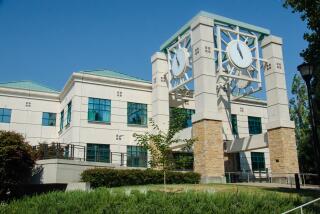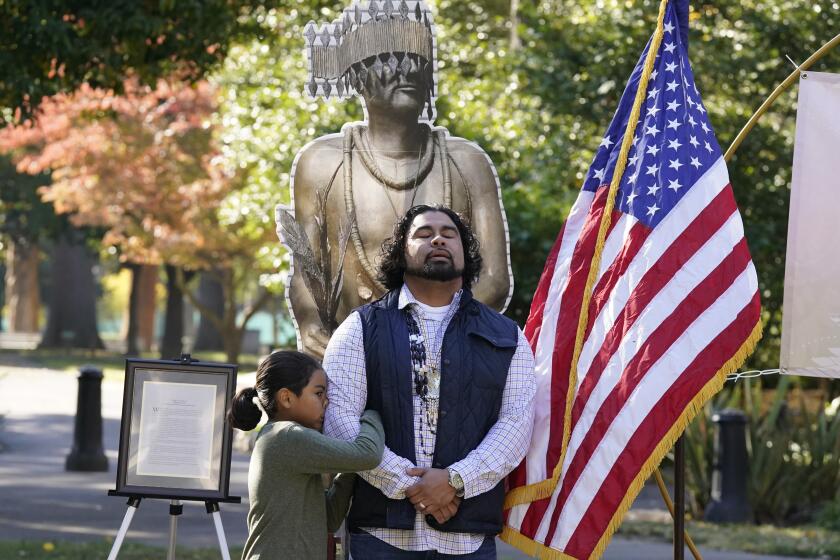Divers Anchor Hopes on Clipper Ship Wreck
An underwater exploration of what has been called the most important shipwreck in California history is providing new information about how the ship met its ultimate fate and may lead to the first detailed understanding of how the ships known as Baltimore Clippers were constructed.
A team of archeologists has just completed two weeks of diving on the 150-year-old wreckage of the Frolic, located just offshore near the Point Cabrillo lighthouse about 100 miles north of San Francisco.
Although amateur divers have been salvaging artifacts from the wreck for more than 40 years, this month’s expedition marks the first time that the site has been formally surveyed -- the first step in retrieving more artifacts and turning the site into a protected underwater state park.
The 200-ton Frolic, which was carrying trade goods from China to San Francisco, is the only clipper known to have sunk on the West Coast, and its demise led directly to the large-scale exploitation of timber and other resources in Northern California. Had it reached San Francisco safely with its cargo intact, the redwood and fir forests in the area of the wreck would not have been observed by salvagers and exploitation might have been delayed by many years.
Although the ship has been badly damaged by time and tides -- much of the wood has disintegrated -- enough remains in place that researchers should be able to document its construction, according to archeologist Tom Layton of San Jose State University, a leading expert on the Frolic.
“There is a big debate over what the hulls of the Baltimore Clippers looked like because there aren’t any of them left,” Layton said. “Now we may be able to answer the question.”
Added Charles Beeker of Indiana University, who led the expedition, “This ship is a porthole into the past.”
The Frolic was built by Boston merchants in 1844 to run opium from India to China. But it became obsolete for that purpose only five years later when the routes were taken over by steam vessels -- which were more costly to operate, but which could be insured much more cheaply because of their ability to maneuver away from navigational hazards.
Its owners then decided to use it to carry trade goods from China to San Francisco to fill the needs of the miners in the California Gold Rush. In command, they placed Capt. Edward Horatio Faucon, who was already world-famous as the hero of Richard Henry Dana’s book “Two Years Before the Mast.” Among other cargo, it carried a prefabricated house, 21,000 porcelain bowls, 6,109 bottles of Scottish ale that had been bottled in China, trunks of silk fabric and furniture.
On a calm, clear summer evening in 1850, captain and crew saw the coastal mountains near what is now Point Cabrillo. What they didn’t see, until it was too late, were the whitecaps breaking over the reefs offshore. Faucon brought the ship around, but the lack of wind hindered his escape and the Frolic’s stern was holed.
In letters to the insurance company and the Frolic’s owners, Faucon said he and his men abandoned the ship in two longboats, rowing ashore at the mouth of a river in what is now Mendocino. “But captains generally do not abandon their ships offshore,” Layton said. “They generally try to get into shore.”
The new investigation suggests that that is what happened here.
In eight days of diving, Beeker’s team discovered that the ship had been run aground prow first. That suggests the action was deliberate, Layton said.
“Every other shipwreck not intentionally grounded is located broadside to the coastline,” added team member Sheli Smith, an archeologist at Napa Valley College.
The placement of the anchors in the wreckage confirmed that they had been used, probably in conjunction with the longboats, to turn the Frolic so that its sails would drive it aground, she added.
The team mapped the ship “from bow to stern,” Beeker said. Despite the 40 years of salvaging, “there is a lot of material in the water,” he added, most of it still located in its original position. “The wood is virtually all gone,” he noted. “We can’t really think of it as a shipwreck any more. It’s a submerged cultural resource.”
The team hopes to return next summer to perform its own salvage, adding artifacts to the more than 1,200 that have been returned to the state’s possession by amateur divers.
But the story doesn’t end with the grounding of the ship. Its owners sent a team of salvagers headed by Jerome Ford overland, hoping to recoup some of their losses. The cargo was ruined, but Ford, a savvy businessman, noted the presence of large forests of redwood and fir. Within a year, a lumber mill had been built at Mendocino and the course of development altered irrevocably.
The new industry had a disastrous effect on the Pomo Indians indigenous to the area. Although they benefited briefly by raiding the wreck themselves -- contemporary reports recount tales of Indians clad in Chinese silks -- the Pomo were ultimately forced into reservations, in part because of conflicts with the burgeoning timber industry.
The expedition was sponsored in part by the Discovery Channel, through the Point Cabrillo Lightkeepers Assn. Members of the association provided food, housing and support for the diving team. The expedition will be the subject of a television program in November. More information is available at www.pointcabrillo.org.
More to Read
Start your day right
Sign up for Essential California for news, features and recommendations from the L.A. Times and beyond in your inbox six days a week.
You may occasionally receive promotional content from the Los Angeles Times.






